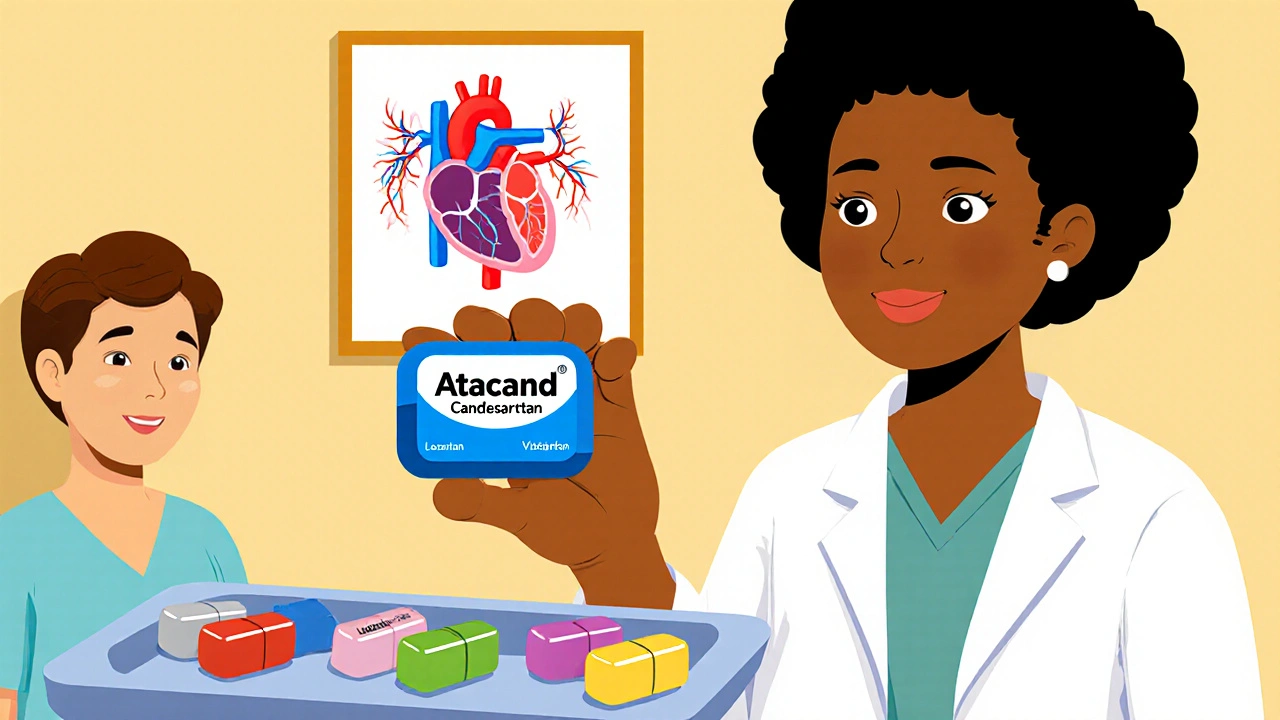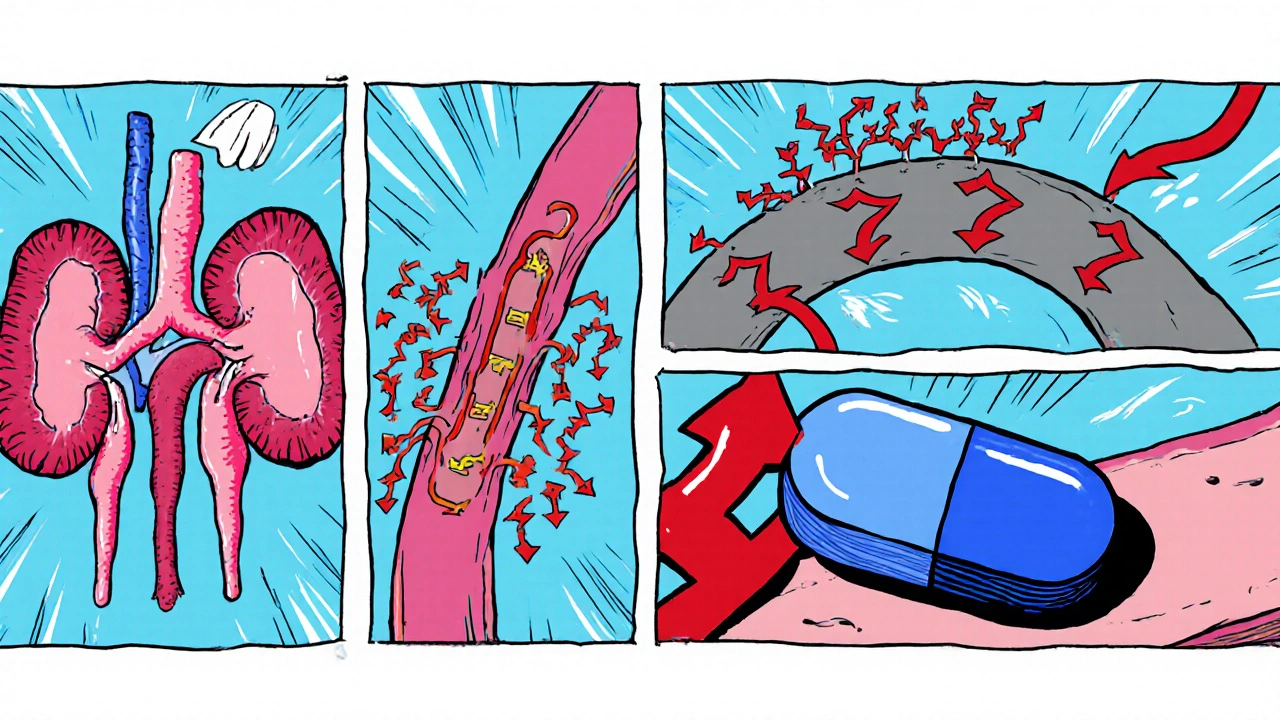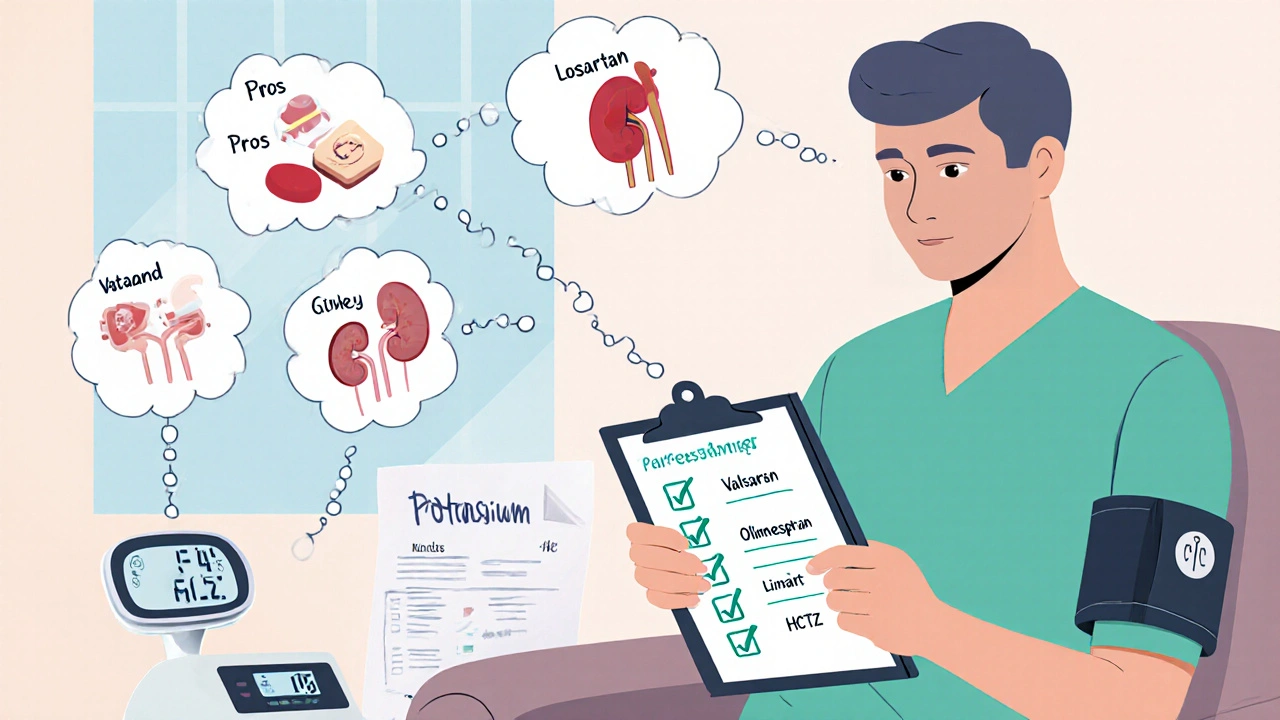
Blood Pressure Medication Selector
Find Your Best Blood Pressure Medication
This tool helps you understand which blood pressure medication might be most suitable for your individual health profile. Based on factors like kidney function, comorbidities, and side effects, we'll recommend the most appropriate options.
When your doctor prescribes Atacand, you’re really getting Candesartan, a once‑daily angiotensin II receptor blocker (ARB) that helps lower blood pressure and protect your heart. But the market is crowded - dozens of pills promise the same outcome. How do you know if Atacand is the right fit, or if another drug might work better for you?
Key Takeaways
- Atacand belongs to the ARB class and is especially helpful for patients who can’t tolerate ACE‑inhibitors.
- Common ARB alternatives (Losartan, Valsartan, Olmesartan) share similar efficacy but differ in dose flexibility and drug‑interaction profiles.
- ACE inhibitors such as Lisinopril often cause a dry cough, a side‑effect that many ARBs avoid.
- Combination therapy - pairing an ARB with a thiazide diuretic or calcium‑channel blocker - can improve control in resistant hypertension.
- Choosing the best option depends on kidney function, age, comorbidities, and how your body reacts to side effects.
How Atacand Works: The Science in Plain English
The renin‑angiotensin‑aldosterone system (RAAS) is a hormonal cascade that narrows blood vessels and raises blood pressure. Angiotensin II is the main culprit; it binds to the AT1 receptor on vessel walls, causing them to constrict.
Atacand blocks that receptor, preventing angiotensin II from tightening the arteries. The result is a smoother, wider passage for blood, lower pressure, and reduced strain on the heart. Because it works downstream of the enzyme that creates angiotensin II, ARBs like Candesartan avoid the “ACE‑inhibitor cough” that many patients report.
What to Look at When Comparing Blood‑Pressure Drugs
Not all antihypertensives are created equal. Below are the six criteria we use to stack the contenders side‑by‑side:
- Efficacy: How well does the drug lower systolic and diastolic numbers?
- Safety profile: Risk of cough, swelling, kidney issues, or electrolyte disturbances.
- Dosing flexibility: Once‑daily vs. multiple doses, available strengths.
- Drug‑interaction potential: Especially with NSAIDs, potassium‑sparing agents, or other antihypertensives.
- Cost and insurance coverage: Generic availability often decides real‑world adherence.
- Special population data: Evidence for use in the elderly, diabetics, or patients with chronic kidney disease.
Comparison Table: Atacand vs. Popular Alternatives
| Drug | Class | Typical Dose Range (once daily) | Key Side Effects | Pros | Cons |
|---|---|---|---|---|---|
| Atacand (Candesartan) | ARB | 4 mg - 32 mg | Dizziness, hyperkalemia (rare) | No cough, good kidney tolerance | More expensive than some generics |
| Losartan | ARB | 25 mg - 100 mg | Dizziness, back pain | Widely used, inexpensive generic | Less potent dose‑response curve |
| Valsartan | ARB | 80 mg - 320 mg | Headache, hyperkalemia | Strong evidence for heart‑failure benefit | Potential for drug‑interaction with cytochrome P450 inhibitors |
| Olmesartan | ARB | 5 mg - 40 mg | Diarrhea, rare sprue‑like enteropathy | Very potent, low dose needed | Enteropathy concerns limit use in some patients |
| Lisinopril | ACE‑inhibitor | 5 mg - 40 mg | Persistent dry cough, angioedema | Long track record, cheap | Cough leads to discontinuation in ~10 % of users |
| Hydrochlorothiazide (HCTZ) | Thiazide diuretic | 12.5 mg - 50 mg | Low potassium, gout flare | Works well in combination therapy | Electrolyte shifts require monitoring |

Deep Dive into Each Alternative
Losartan was the first ARB approved in the U.S. (1995) and remains a go‑to option when cost matters. Its half‑life is shorter than Candesartan, so patients with erratic adherence sometimes see more blood‑pressure “wiggle”. Losartan also has a modest effect on reducing proteinuria, making it useful for early diabetic kidney disease.
Valsartan shines in heart‑failure patients. Large trials (e.g., VALIANT) showed a 14 % reduction in cardiovascular death when paired with beta‑blockers. However, Valsartan is metabolized by CYP2C9; drugs like fluconazole can raise blood levels, a factor to keep in mind if you’re on antifungals.
Olmesartan is the most potent ARB per milligram, which means you can stay on a lower dose. The trade‑off is its rare association with a sprue‑like enteropathy - chronic diarrhea and weight loss that mimics celiac disease. If you develop unexplained GI symptoms after starting Olmesartan, a quick switch can solve the problem.
Lisinopril and other ACE inhibitors have been the backbone of hypertension therapy for decades. They lower blood pressure about as well as ARBs but bring a dry cough in roughly one‑tenth of patients. For those who can tolerate it, ACE inhibitors are slightly cheaper than most ARBs, especially in generic form.
Hydrochlorothiazide is not an ARB or ACE‑inhibitor, but it’s often paired with them to hit target numbers faster. It works by flushing excess sodium, which reduces blood volume. The downside is potassium loss, so many clinicians add a potassium‑sparing agent or monitor labs closely.
When Atacand Might Be the Better Choice
- ACE‑inhibitor intolerance: If you’ve tried Lisinopril and got a cough, switching to an ARB like Candesartan avoids that problem.
- Kidney protection: Candesartan has solid data showing slowed progression of diabetic nephropathy, similar to ACE inhibitors but with fewer pulmonary side effects.
- Once‑daily simplicity: The long half‑life (≈9 hours) allows steady blood levels over 24 hours, supporting adherence.
- Combination pills: Atacand is available in a fixed‑dose combo with HCTZ (Candesartan/HCTZ), useful for patients needing two agents.
Scenarios Where Another Drug May Outperform Atacand
If you’re on multiple medications that affect the cytochrome P450 system, Valsartan’s interaction profile might be a red flag, pushing you toward Losartan instead. For patients with a history of GI issues, Olmesartan’s rare enteropathy warrants caution, making Losartan or Candesartan safer bets. In low‑income settings, the price advantage of generic Losartan often outweighs the marginal efficacy difference.

Practical Checklist Before Switching or Starting Therapy
- Review recent labs: serum potassium, creatinine, eGFR.
- Ask about cough, swelling of lips/tongue, or unusual diarrhea.
- List all current meds - especially NSAIDs, potassium supplements, or other antihypertensives.
- Confirm insurance coverage for the chosen drug and its dosage.
- Set a follow‑up appointment in 2-4 weeks to reassess blood pressure and side effects.
Bottom Line: Personalize Your Blood‑Pressure Plan
There’s no one‑size‑fits‑all answer. Atacand (Candesartan) offers solid efficacy, a clean side‑effect profile, and convenient once‑daily dosing, making it a strong first‑line ARB. However, losartan’s low price, valsartan’s heart‑failure data, and olmesartan’s potency give each alternative a niche where it shines. Talk with your clinician, bring your lab results, and weigh the pros and cons listed above - that’s the fastest route to a blood‑pressure regimen that sticks.
Frequently Asked Questions
Can I take Atacand with a thiazide diuretic?
Yes. A fixed‑dose combo of Candesartan and hydrochlorothiazide is FDA‑approved and often more effective than either drug alone.
What’s the main difference between ARBs and ACE inhibitors?
Both block the renin‑angiotensin system, but ARBs block the receptor while ACE inhibitors stop the enzyme that creates angiotensin II. ARBs typically avoid the dry cough that ACE inhibitors can cause.
Is Candesartan safe for people with kidney disease?
It’s generally safe and can slow kidney damage progression, but dosing must be adjusted based on eGFR, and potassium levels need monitoring.
How quickly does Atacand start lowering blood pressure?
Blood‑pressure reductions are usually seen within 2 weeks, with the full effect reached after about 4-6 weeks of consistent dosing.
Can I switch from Losartan to Atacand without a wash‑out period?
Yes. Because both are ARBs, you can transition directly, but keep an eye on blood pressure and potassium during the first few days.
8 Comments
Veronica Appleton
November 3, 2025 at 00:40 AM
Make sure you check your potassium and kidney labs before starting any ARB. If you’re already on a thiazide, monitor for low potassium especially with candesartan. The combo pill of Atacand and HCTZ can simplify dosing but watch for dizziness at first. Insurance coverage often favors the generic ARBs so call your pharmacy.
the sagar
November 11, 2025 at 13:45 PM
Don’t trust the pharma push; they hide the truth.
Clinton Papenfus
November 20, 2025 at 02:51 AM
It is advisable, dear reader, to consider the pharmacokinetic profile of each agent prior to selection. Candesartan possesses a half‑life that permits stable plasma concentration over twenty‑four hours, thereby enhancing adherence. Losartan, by contrast, exhibits a shorter duration necessitating vigilance in patients with irregular dosing habits. Valsartan’s metabolic pathway may interact with cytochrome inhibitors, an aspect worthy of physician attention.
Zaria Williams
November 28, 2025 at 15:56 PM
Yo, if you’re looking for cheap but decent, losartan is definetly the go‑to. It might not be as potntial as candesartan but it’s everywhere and your wallet will thank you. Some peeps report back pain, but that’s kinda rare and easy to switch. Just remember to keep an eye on your blood work, especially potassium levels.
ram kumar
December 7, 2025 at 05:01 AM
When a patient steps into the clinic, the silence of untreated hypertension looms like a storm on the horizon.
The physician, armed with data and hope, reaches for the toolbox of antihypertensives.
Among the gleaming options, Atacand shines with a promise of renal protection, a promise whispered in the corridors of nephrology.
Yet the cost, like a lurking phantom, haunts the decision, threatening compliance.
The alternative, losartan, rolls onto the scene cheap and familiar, a veteran of countless prescriptions.
Its modest potency can be a double‑edged sword, offering safety at the expense of maximal control.
Valsartan marches in with heroic trial data, its heart‑failure benefits lauded in journals, but it demands respect for drug interactions.
Olmesartan, the quiet heavyweight, lurks with a rare but alarming enteropathy, a reminder that potency carries peril.
In the background, hydrochlorothiazide churns, flushing sodium away, yet steals potassium with every dose.
The clinician must balance these forces, a tightrope act between efficacy, safety, and economics.
Patients, meanwhile, wrestle with side‑effects, the dreaded cough of ACE inhibitors, the dizzy spell of ARBs.
Each symptom becomes a narrative, a story that either cements trust or breaks it.
The pharmacy counter becomes a battlefield where insurance formularies dictate the victor.
The heart of the matter is not just numbers on a cuff, but the lived experience of the individual.
In the end, a shared decision, rooted in transparent dialogue, offers the best chance for lasting control.
And so the cycle continues, a perpetual dance of science, cost, and compassion.
Melanie Vargas
December 15, 2025 at 18:07 PM
Remember, you’re not alone on this journey 😊. Finding the right BP med is a partnership between you, your doctor, and your lifestyle. If Atacand feels right, give it a fair trial of a month before switching. Keep a simple log of your readings, mood, and any side effects, then share it at your next visit. 🌟
Deborah Galloway
December 24, 2025 at 07:12 AM
Hey, I totally get how overwhelming all these drug choices can be. It helps to think of your priorities-whether it’s cost, side‑effects, or dosing simplicity. Talk openly with your prescriber about what matters most to you. A calm, honest conversation usually lands you the best fit.






Sarah Keller
October 25, 2025 at 12:34 PM
Thinking about blood‑pressure meds is more than checking a box; it's about how our bodies respond to the invisible push of the renin‑angiotensin system. Atacand offers a clean block of that pathway without the notorious cough that haunts ACE inhibitors. If you value consistency and a simple once‑daily routine, it stands out as a solid first‑line ARB. Yet, we shouldn't ignore the cost factor-some patients feel the pinch compared with generic losartan. So weigh the trade‑off between convenience and expense before you settle.